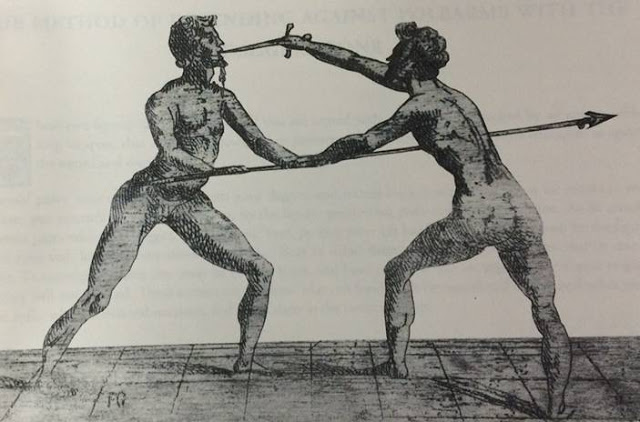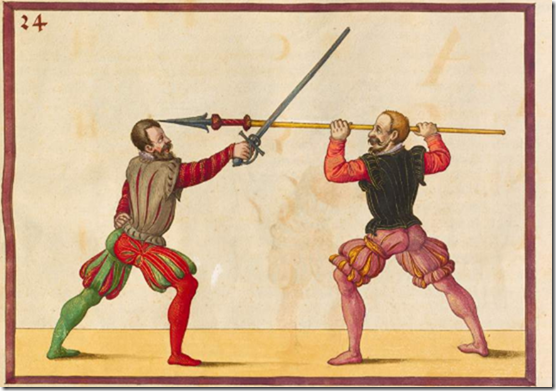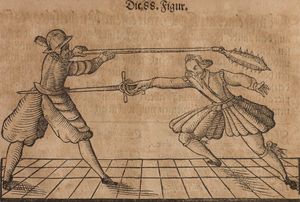| Author |
Message |
|
Timo Nieminen
|
 Posted: Tue 31 Jul, 2012 2:26 pm Post subject: Posted: Tue 31 Jul, 2012 2:26 pm Post subject: |
 |
|
| Julian Reynolds wrote: | | Plus, as said before, longsworders are more than used to tackling a weapon with a long reach. Getting in past their point gives you an advantage. It is much more a test of your skill than the size of your equipment! |
By "long reach", do you mean other longswords (equality, rather than inferiority) or long weapons like staff, spear (and other polearms) and two-handed sword? I'd say that any longsworder who is (realistically) confident against polearm and two-handed sword should be confident against rapier. (But watch that dagger!)
"In addition to being efficient, all pole arms were quite nice to look at." - Cherney Berg, A hideous history of weapons, Collier 1963.
|
|
   |
 |
|
Julian Reynolds
Location: United Kingdom Joined: 30 Mar 2008
Posts: 271
|
 Posted: Tue 31 Jul, 2012 2:55 pm Post subject: Posted: Tue 31 Jul, 2012 2:55 pm Post subject: |
 |
|
I think, to look for similarities in their physical/mechanical properties, and likewise look for 'equalities', is a mistake. They handle completely differently, and are handled (used) completely differently. That is the challenge in competing one against the other.
Julian
|
|
  |
 |
|
Timo Nieminen
|
 Posted: Tue 31 Jul, 2012 5:18 pm Post subject: Posted: Tue 31 Jul, 2012 5:18 pm Post subject: |
 |
|
| Julian Reynolds wrote: | | I think, to look for similarities in their physical/mechanical properties, and likewise look for 'equalities', is a mistake. They handle completely differently, and are handled (used) completely differently. That is the challenge in competing one against the other. |
I certainly agree with the last part, but not entirely with the first part.
Reach, speed, and leverage are applicable to both weapons, and the relative performance of the weapons in these respects must surely affect the way one fights against the other weapon. While a longsword remains a longsword, it would be a mistake to fight the same way against a dagger and a spear (or even against a longsword and a spear). Insofar as physical properties determine length, mass, and where hands can be placed on the grip, they tell us a lot.
The rest of what we were discussing about physical/mechanical properties is quite peripheral to questions of handling, concerning whether one of the weapons can destroy the other too easily. But surely this too is important to the question of how to fight A versus B. (Less so to compete A versus B.)
Where I do agree with the first part is that it isn't similarities/equalities that matter, but the differences, and how big they are.
"In addition to being efficient, all pole arms were quite nice to look at." - Cherney Berg, A hideous history of weapons, Collier 1963.
|
|
   |
 |
Glen A Cleeton

|
|
  |
 |
|
Steve Hick
Location: United States Joined: 28 May 2009
Posts: 46
|
 Posted: Fri 03 Aug, 2012 4:56 pm Post subject: Posted: Fri 03 Aug, 2012 4:56 pm Post subject: |
 |
|
| Vincent Le Chevalier wrote: | I don't think the longsword should have any advantage in blade length... It seems that the debate about reach stems from the simulators available, not from the actual proportion of weapons.
If you look at what masters show in their work, the shortest blades are illustrated by Thibault and amount to roughly three fifth of a man's height. At 5'11 (1.80m) like me this gives 43in. For 37in this gives a height of 5'1 (1.56m) which is not average for men anyway...
Thibault is actually on the short side for rapiers, and says so himself. He writes that some people recommend swords that go from feet to armpit of a standing man. The illustrations in Italian manuals tend to agree with that length. That gives almost a foot more of blade length.
I have the montante trainer from Arms&Armor and it is marginally longer in blade than my 42in Darkwood rapier, but cannot efficiently be wielded in one hand. So the length difference is made up by the one-handed vs. two-handed grip. A longsword that can be wielded by one hand would have to be quite a bit shorter, especially if it has to have more blade mass than a rapier to make better cuts.
Thibault says to avoid parrying the cuts of the great sword and I think this is sound advice. He does bind against it but this works mainly because of the longer blade of the great sword I believe. Against shorter longswords I'd use the same tactics against cuts (thrust before the cut starts, thrust after the cut falls, avoiding contact, or divert the cut then glide a thrust in the same motion), and otherwise try to disengage around the longsword to negate leverage and use the nimbleness of a single hand grip.
Regards, |
Thibault is reiterating the points given by Pacheco that the destro with his sword can defeat the two handed sword by means of encountering it and controlling it with an atajo. THis was not universally held by other teachers of the same general school, la Verdadera Destreza,as Dias de Viedma has in his section on the montante:
" It is said that with a sword one can parry a montante, but since that play cannot be made without notable danger to the combatants, it is never done. " why you never see it, and why in our simulations it seems that this is untrue is that we are conducting "polite play" without deadly intent, as de Viedma further adds "The montante is considered to be a weapon of little courtesy, and a weapon that is the enemy of its own master, because when one begins to fight with it, one is unable to act courteously; and thus it is only used if a man is compelled to defend his life, and to ensure that he is able to secure his person without having respect for anyone else. For this purpose, it is good, or for clearing space [in a crowd]."
The montante is also taught by maestros who adhere to the various types of la Verdadera Destreza to be able to defeat multiple opponents, and superior to the sword alone.
From Perez de Mendoza "Its teaching is more important than the single sword or the other weapons, which is only equaled by the mangual because of its great strictness and its handling. In one of the preceding assertions it is said that the sword is not the queen of them all, because if it will be that way, one does not prefer the montante, which is done with all, even though they make use of the doubles, and oppose it with those two or three at a time, whether the arms are offensive or shielding." in his 31st assertion
And in his 26th Mendoza write "In the doctrine that I have seen written by many masters on the Art of Arms, it is said that the sword is superior to all other forms of weapon, and they name it the Queen of all of them. And that the sword alone can operate against the sword and dagger, sword and buckler, against sword and round target, against sword and cape, and against the montante. But they fail to warn about what could happen against two swords, and the doubt they have that it would be unable to work against these. This may be due to the fact that they have not studied this, nor paid attention to the paths which must be followed with them. And they avoid this problem by making the sword Queen of all the weapons, and they assert this in their writings. But in them, although they speak in abstract regarding the teaching of double weapons, they do not put it into practice, aside from just discussing it orally"
So they argued the issue among themselves, even the masters. I don't have to have the specific Pacheco quote handy at the moment, but could dig it up, if someone really wants it.
Steve
Steve Hick
|
|
   |
 |
|
Nic James Cabrera
Location: United States Joined: 11 Sep 2016
Posts: 1
|
 Posted: Sun 11 Sep, 2016 10:47 am Post subject: Posted: Sun 11 Sep, 2016 10:47 am Post subject: |
 |
|
| Julian Reynolds wrote: | Spear vs Rapier - sorry, very improbable, no wonder you can't find anything.
Rapier is not primarily a battlefield weapon, although they were carried on the field (usually with a heavier blade than one would normally associate with a civilian rapier). At a pinch, you could possibly justify rapier against a 'badge of rank' polearm such as a spontoon/partizan/halberd, or try it against massed pike (good luck!). But a spear was an unlikely adversary for a rapier.....
Julian |
Actually a few fencing masters included rapier vs spear in their works to the idea of rapier vs spear may not be as improbable as you might think.
 Attachment: 58.04 KB Attachment: 58.04 KB

Giganti with dagger
 Attachment: 316.68 KB Attachment: 316.68 KB

 Attachment: 19.88 KB Attachment: 19.88 KB

 Attachment: 134.99 KB Attachment: 134.99 KB
Fabris [ Download ]
Nicolas J Cabrera
|
|
  |
 |
Benjamin H. Abbott

|
 Posted: Sun 11 Sep, 2016 1:15 pm Post subject: Posted: Sun 11 Sep, 2016 1:15 pm Post subject: |
 |
|
Yeah, at least in England, it was far from unheard of for civilians to carry staff weapons. Consider this passage from William Harrison's 1577 description of England:
| Quote: | | This nevertheless will I add of things at home, that seldom shall you see any of my countrymen above eighteen or twenty years old, to go without a dagger, at the least, at his back or by his side, though they be aged burgesses, or magistrates of any city, who in appearance are most exempt from brabbling and contention. Our nobility wear commonly swords or rapiers with their daggers, as doth every common serving man also that followeth his lord and master. Some desperate cutters we have in like sort, which carry two daggers or two rapiers in a sheath always about them, wherewith in every drunken fray they are known to work much mischief; their swords and daggers also are of great length, and longer than the like used in any other country, whereby each pretendeth to have the more advantage of his enemy. But as many orders have been taken for the intolerable length of these weapons, so I see as yet small redress; but where the cause thereof doth rest, in sooth for my part I wot not. I might here speak of the excessive staves which divers that travel by the way do carry upon their shoulders, whereof some are twelve or thirteen foot long, besides the pike of twelve inches: but as they are commonly suspected of honest men to be thieves and robbers, or at the leastwise scarce true men that bear them; so by reason of this and the like suspicious weapons, the honest traveller is now enforced to ride with a case of dags at his saddle-bow, or with some pretty short snapper, whereby he may deal with them further off in his own defence, before he comes within the danger of these weapons. Finally, no man travelleth by the way without his sword, or some such weapon, with us; except the minister, who commonly weareth none at all, except it be a dagger or hanger at his side. |
So various people carried long rapiers and various people bore spears/pikes (and some carried pistols, though that's not relevant here). It seems plausible that encounters between the single rapier and spear or such like weapon happened in this period, though it'd take some courage to face a spear with the rapier alone.
During the same era, Joachim Meyer penned techniques for the rapier (in his case, a sword fit for both thrust and cut) against the partisan. I believe some of the Italian rapier masters included such techniques as well.
Anyway, George Silver certainly thought the longsword had the advantage over the single rapier and the rapier and dagger.
|
|
  |
 |
|
|
You cannot post new topics in this forum
You cannot reply to topics in this forum
You cannot edit your posts in this forum
You cannot delete your posts in this forum
You cannot vote in polls in this forum
You cannot attach files in this forum
You can download files in this forum
|
All contents © Copyright 2003-2024 myArmoury.com — All rights reserved
Discussion forums powered by phpBB © The phpBB Group
Switch to the Basic Low-bandwidth Version of the forum
|

